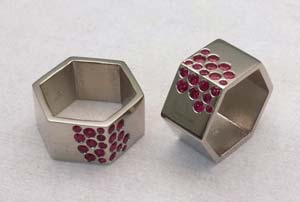The platinum Metals Group consists of six metals: platinum, palladium, rhodium, iridium, ruthenium and osmium. The metals are chemically similar and usually are found together in their ores. As a group, they share many common characteristics such as high melting points, resistance to corrosion, and excellent hardness. All of these metals are relatively scarce and are very expensive relative to gold (see Chart A).
| Chart A | "Spot Price" of Gold Relative to the Platinum Metals Group | ||||||
|---|---|---|---|---|---|---|---|
| Metal | Gold | Platinum | Palladium | Rhodium | Iridium | Ruthenium | Osmium |
| Spot Price (US Dollar) | $425 | $825 | $285 | $450 | $215 | $42 | $150 |
| Relative Color |  |  |  |  |  |  |  |
Despite their high costs they are considered extremely valuable for their unique engineering properties and functional versatility. In particular, platinum, palladium, and ruthenium are used extensively for the electroplating of electronic components, semiconductor packaging, and other specialized engineering applications.
Characterized by their excellent hardness (chart b) and bright finishes, very thin electroplated coatings (1.0 microns or less) produce exceptional long term anti-tarnish protection on plated surfaces. Thicker platings of up to 6 microns are sometimes utilized for highly specialized engineering applications (platinum-aluminide coatings). In general, the thicker the electroplated layer the more brittle the surface deposits become (i.e. platinum, rhodium).
The platinum metals group are also used as alloys in other electroplating formulas. Ruthenium and osmium in trace amounts, can dramatically improve the durability and hardness of gold-plated and palladium finishes.
The color appearance of this metal group varies from a light silver gray to a bright blue-white silver appearance (rhodium). Moving into the darker color range, electroplated ruthenium finishes can be modified to appear from light gray to almost black in color. In addition, surface modifications using chemical etching or glass bead blasting can create some unique and attractive finishes for decorative applications (i.e. watches, bracelets).
| Chart B | Chart B Basic Properties of the Platinum Metals Group | |||||
|---|---|---|---|---|---|---|
| Metal | Platinum (Pt) | Palladium (Pd) | Rhodium (Rh) | Iridium (Ir) | Ruthenium (Ru) | Osmium (Os) |
| Melting Point (F) | 3221.6° | 2825.6° | 3570.8° | 4370.0° | 4082.0° | 5513.0° |
| Vickers Hardness | 41 | 41 | 101 | 220 | 240 | 350 |
| Color Appearance | Light-Gray | Gray-White | Blue-White | Blue-Gray | Gray-Light Black | Silver-White |
| Mohs Hardness* | 4.3 | 4.8 | 5.5 | 6.25 | 6.5 | 7.0 |
| *For reference, fine gold is 2.75, silver is 3.25, copper is 2.75 | ||||||
Different plating thicknesses are utilized by industry depending on the application. For engineering applications very thin deposits are used as a pre-plate to increase resistance to corrosion, or to impart a different performance characteristic to the component (i.e. conductivity). Referring to chart c, very thin coatings are sufficient for most decorative or engineering tasks. For example, rhodium is plated onto decorative objects to prevent tarnish and discoloring. Thicknesses of .05 microns can dramatically increase the long term durability, brightness and luster of the initial commercial finish.
Thin platinum deposits (platinized) are widely used as an economical and protective coating to prevent contamination of chemicals or liquids by a basis metal substrate (i.e. nickel). In the medical field, the inert and noble properties of the platinum metals group are used to electroplate medical instruments such as catheters and connectors for surgical equipment.
| Chart C | Typical Plating Thickness Range of the Platinum Metals Group | |||||
|---|---|---|---|---|---|---|
| Metal | Platinum (Pt) | Palladium (Pd) | Rhodium (Rh) | Iridium (Ir) | Ruthenium (Ru) | Osmium (Os) |
| Typical Plating Range (Microns) | .20–5.0 | .20–1.25 | .05–2.5 | .10–.90 | .20–1.5 | .05–.50 |
| Military Spec | — | MIL-P-45209B | MIL-R-46085B | — | — | — |
The platinum metals group also have an important technical role in decorative electroplating industry. Palladium coatings are used widely in Europe as a pre-plate replacement for nickel under gold plated finishes. Rhodium electroplating is very popular as a protective decorative finish for white gold items, silver jewelry and tableware.
It is considered best in class of all the platinum metals family for resistance to corrosion and sulfur oxides. Rhodium will also remain bright under most environmental conditions. Of all the metals in this group, rhodium is by far the most expensive to utilize. Fortunately, heavy electroplated coatings are not necessary for most applications.
Ruthenium is also finding a bigger role as a decorative finish, especially for contemporary watch cases. The finish is quite hard and it has an unusual gray-black appearance that is quite durable.
Iridium and osmium have a relatively minor role as electroplated finishes, when compared to platinum and palladium. They are utilized in some specialized applications for aerospace and military components.
Regardless of costs, electroplating applications for the platinum metals group will continue to expand further into the electronics industry and catalytic sciences field. Their unique properties combined with more precise electroplating techniques will enable industry to exploit their engineering properties well beyond today’s capability.
[fblock title=”For additional Information…” icon=” fa-book fa-fw”]For additional information regarding electroplating and metal refinishing, be sure to visit our faqs section located on this site. If we can assist you in your custom plating and metal refinishing needs, please contact us.[/fblock]
[row][one_half]
Metal Arts Specialties
[contact tel=”+1 (248) 821-3450″ email=”[email protected]” /]
8AM–6PM EST[/one_half][/row]


